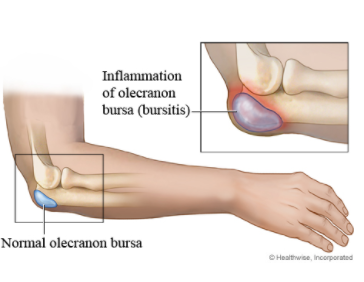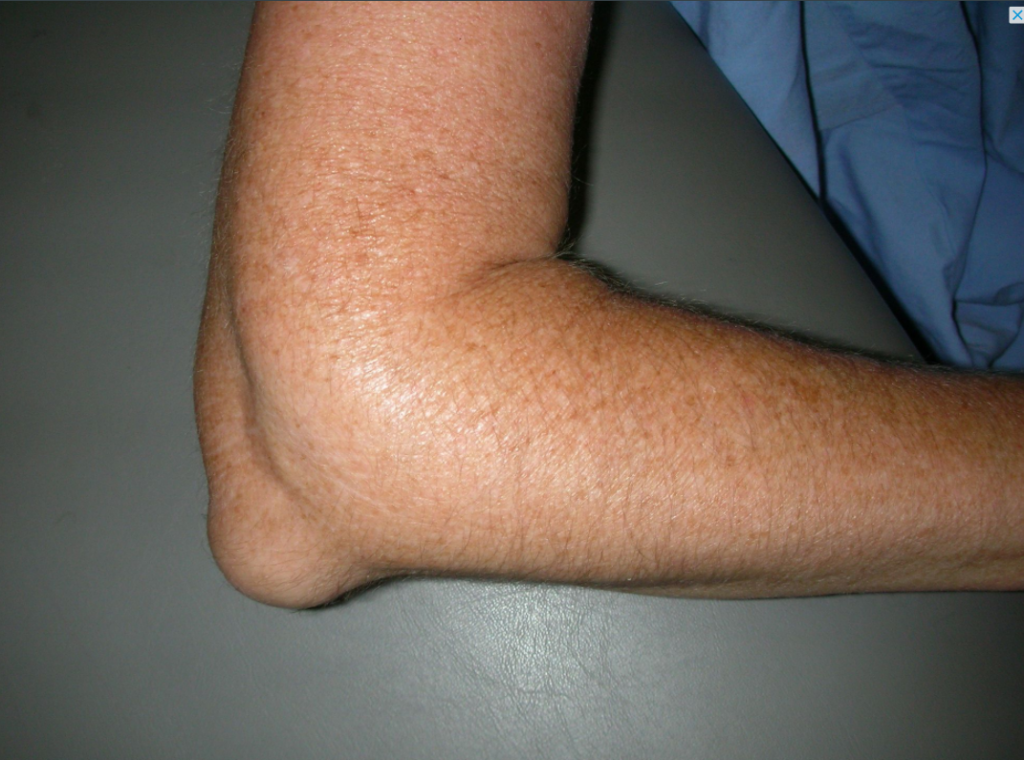Olecranon Bursitis
What is Olecranon Bursitis?
Olecranon bursitis is when the normally deflated sack behind the elbow becomes inflamed and swollen (see picture).
What causes Olecranon Bursitis?
Olecranon bursitis can occur from a single injury such as from a fall, or it can be caused by repeated irritation such as from prolonged use of an arm rest in a car or at a desk. When this happens the body will fill the bursa with more of the bodies natural oil (lubrication). This will cause the bursa to swell. Sometimes it can swell to the size of a tennis ball (see picture).
What are the symptoms of Olecranon Bursitis?
Swelling over the back of the elbow is the most common symptom. Olecranon bursitis usually does not hurt. The swollen bursa can get in the way while using the arm. Some people with a swollen bursa find it ugly.
Swelling of the bursa is generally not an emergency. However, if it gets infected it can need urgent treatment. Infected olecranon bursitis can be an emergency. Warmth, redness and pain are signs that it may be infected. If this happens then the person should go immediately to their doctor or to the emergency room.
How can you tell if you have Olecranon Bursitis?
Swelling over the back part of the elbow is almost always present. Your doctor will need X-rays to evaluate the underlying bone. An MRI is generally not needed.
If the bursa is infected then warmth, redness and pain are also usually present. This usually requires a visit to the doctor.
How is Olecranon Bursitis treated?
If the swollen bursa is not infected there are three main treatment plans. First, it can be ignored. The swollen bursa does no damage to the person. Sometimes it goes away on its own and sometimes it does not.
The second treatment plan involves wrapping the elbow and bursa to apply gentle pressure to try squeezing the fluid out of the bursa back into the body. The wrap also serves to protect the elbow against more irritation. The wrap must be worn around the clock for up to 6 weeks. If the hand starts to swell then the wrap is too tight..
Third, is surgical removal of the olecranon bursa. In this simple operation, the bursa is simply cut out. After surgery the elbow is kept in a sling for 2 weeks, followed by range-of-motion therapy and a return to normal function. Over time a new bursa, free of scar tissue, usually will re-form. The main complications from this surgery are infection and a return of the bursitis.
Sticking a needle in the bursa to remove the fluid is rarely the right thing. This is because simply removing the existing fluid does nothing for the underlying problem. Therefore the fluid often comes back very soon. Also, the risk of infection increases with each needle stick.
If the olecranon bursa becomes infected the person will usually be placed on antibiotics until the infection is resolved. Sometimes, with bad infections, immediate surgical removal of the bursa is needed.

Normal Bursa vs Bursitis
